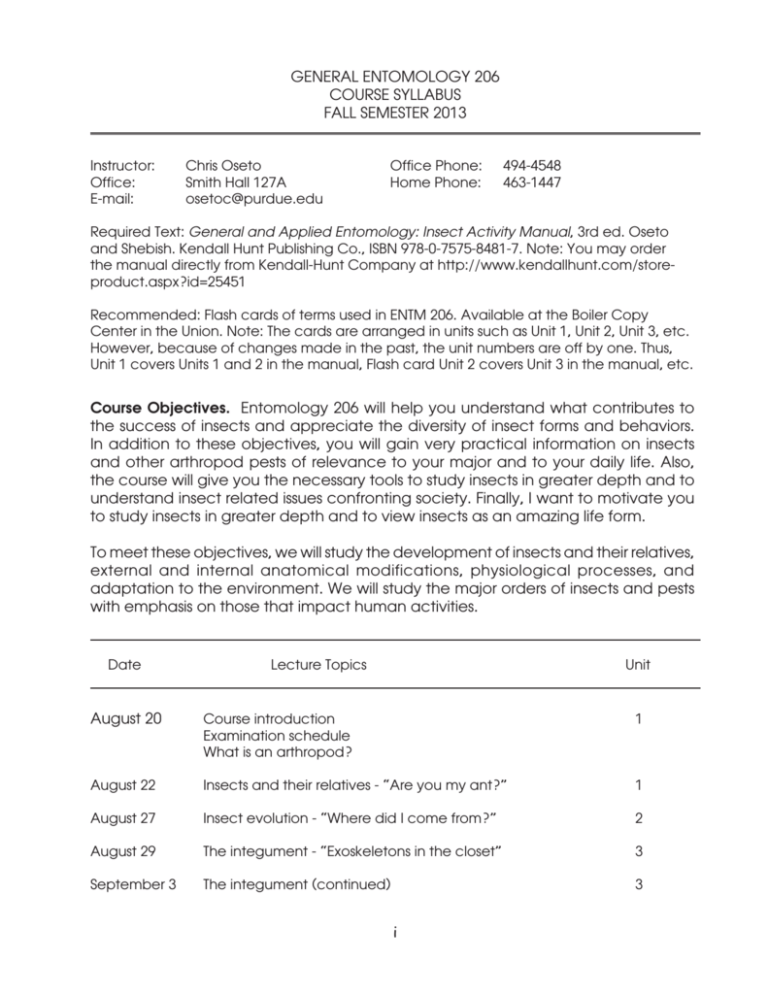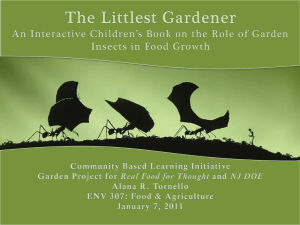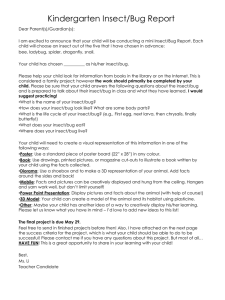i GENERAL ENTOMOLOGY 206 COURSE
advertisement

GENERAL ENTOMOLOGY 206 COURSE SYLLABUS FALL SEMESTER 2013 Instructor: Office: E-mail: Chris Oseto Smith Hall 127A osetoc@purdue.edu Office Phone: Home Phone: 494-4548 463-1447 Required Text: General and Applied Entomology: Insect Activity Manual, 3rd ed. Oseto and Shebish. Kendall Hunt Publishing Co., ISBN 978-0-7575-8481-7. Note: You may order the manual directly from Kendall-Hunt Company at http://www.kendallhunt.com/storeproduct.aspx?id=25451 Recommended: Flash cards of terms used in ENTM 206. Available at the Boiler Copy Center in the Union. Note: The cards are arranged in units such as Unit 1, Unit 2, Unit 3, etc. However, because of changes made in the past, the unit numbers are off by one. Thus, Unit 1 covers Units 1 and 2 in the manual, Flash card Unit 2 covers Unit 3 in the manual, etc. Course Objectives. Entomology 206 will help you understand what contributes to the success of insects and appreciate the diversity of insect forms and behaviors. In addition to these objectives, you will gain very practical information on insects and other arthropod pests of relevance to your major and to your daily life. Also, the course will give you the necessary tools to study insects in greater depth and to understand insect related issues confronting society. Finally, I want to motivate you to study insects in greater depth and to view insects as an amazing life form. To meet these objectives, we will study the development of insects and their relatives, external and internal anatomical modifications, physiological processes, and adaptation to the environment. We will study the major orders of insects and pests with emphasis on those that impact human activities. Date Lecture Topics Unit August 20 Course introduction Examination schedule What is an arthropod? 1 August 22 Insects and their relatives - “Are you my ant?” 1 August 27 Insect evolution - “Where did I come from?” 2 August 29 The integument - “Exoskeletons in the closet” 3 September 3 The integument (continued) 3 i September 5 The insect head - “Heads up!” 4 September 10 Eyes and antennae - “Facets and feelers” 4 September 11 September 12 Test review, Smith 118 at 6:00 PM Lecture Examination 1 (pp 1-31) Bug Funs 1, 2, 3, 4, 5, 6, 7, 8, 9, 10, 11, and 12 due 1, 2, 3, and part of 4 September 17 The insect thorax - “Stuck in the middle” September 19 The insect thorax (continued) The insect abdomen - “Bringing up the rear” 5 September 24 Abdominal appendages - “Insect beer bellies” 6 September 26 Insect digestion - “Alimentary, my dear Watson!” 7 October 1 Circulation, storage, and excretion - “Have a heart and keep regular” 8 October 3 Respiration - “Do insects need Breathe-rite strips?” 9 October 7-8 October Break October 10 Respiration - (Continued) October 15 Nervous system - “Are tics just nerves?” October 16 Test review, Smith 118 at 6:00 PM October 17 5 6 9 Lecture Examination 2 (pp 32-65) Bug Funs 13, 14, 15, 16, 17, 18, 19, 20, 21 due October 22 Nervous system - “Are tics just nerves?” October 24 Reproduction - “The joys of insex” Rest of Unit 4 5-8 10 11 October 29 October 31 November 5 Reproduction - (Continued) 11 Insect ecology - “Everything in its place” 12 Mimicry - “A mime is a terrible thing to waste” 13 November 6 November 7 Course review, Smith 118 at 6:00 PM Lecture Examination 3 (pp 66-85) 9-12 November 12 Metamorphosis - “Presto-Changeo” 14 ii November 14 November 19 Metamorphosis (continued) 14 Biology of insect orders 16-20 November 20 Test review, Smith 118 at 6:00 PM November 21 Lecture Examination 4 (pp 86-105) 13-14 Bug Funs 22, 23, 24, 25 due Part of Unit 15 covering Collembola to Orthoptera (Note: Unit 15 is a synopsis of the insects orders in units 16-20, and materials in Unit 15 will be covered in the appropriate units.) November 26 Biology of Insect Orders November 27 - 30 16-20 Thanksgiving Holiday December 3 Biology of insect orders 16-20 December 5 Biology of Insect Orders 16-20 Note: There is no test review for the final because you have all the questions for the final. Final Biology of insect orders (pp 106-125) Commodity pests Bug Funs 26, 27, 28, 29, and 30 due I. COURSE REQUIREMENTS A. “A, no B, no D, no A, no B, no C, no D, no B, no A....” Examinations 1. 16-20 Commodity Pests ??? Hourly Examinations a. Will cover materials presented in lectures and handout materials b. The four hourly examinations are not comprehensive c. Test questions will be T/F, multiple guess, matching, and 2. fill-ins Final examination a. Divided into two parts (remainder of the biology of orders and pests) iii b. Student will develop part of the final examination according to his/her area of interest 3. “You can’t collect good grades, you have to earn them.” Grades a. Final letter grade will be based on the performance on hourly examinations, the final examination, attendance quizzes, and Bug Funs Exam 1 = 100 points Exam 2 = 100 points Exam 3 = 100 points Exam 4 = 100 points Final1 = 100 points Final 2 = 100 points Total = 600 points b. II. Extra Credit A. Attendance Quizzes c. Letter grade assignment: A B C D F = = = = = 1. Several unannounced on preceding lecture materials 2. Each quiz worth 2 points 3. B. A missed quizz may not be made up no matter what the circumstance Bug Fun Bonus Activities 1. 2. 600 to 540 539 to 480 479 to 420 419 to 360 359 to 000 Each Bug Fun activity is worth one bonus point All responses for each Bug Fun must be correct to get one point. Incomplete or erroneous answers will void the entire activity iv 3. Read and follow Bug Funs directions carefully 4. Bug Funs due on the dates scheduled in the syllabus, late Bug Funs will not be accepted 5. All Bug Funs must be stapled, and your name must be on EACH Bug Fun page or no points will be awarded 6. Bug Fun points will not be revealed until after the final examination Policy on Make Up Examinations. Any missed lecture examination must be taken as soon as possible but no later than one week after the original examination date. Excused absences will be permitted for deaths in the immediate family or illness verified by a note from a physician. University related events will be considered on a case-by-case basis. ALL MAKE UP EXAMINATIONS WILL BE IN ESSAY FORMAT. Getting hit by a bus is a good excuse... -M! B-A Attendance Policy. Attendance is not taken in class; however, if you don’t come to class, you don’t pass! Academic Dishonesty. Purdue University prohibits cheating, plagiarism, or knowingly providing false information to the University. These acts of cheating or deceit in any form (such as using illegal cribs, copying during examinations, taking examinations for someone else) will not be tolerated and will be dealt with appropriately. v Textbooks. This lecture outline is provided as a guide to the lecture so that you may concentrate on what is being presented in the lecture. No attempt is made to make this outline comprehensive. Thus, space has been provided on each page for additional information presented in lecture. Numerous handouts will be provided during the semester to augment the manual and lecture presentations. For those who wish to consult a textbook, the following are recommended: The Science of Entomology, William S. Romoser and John G. Stoffolano, Jr. 595.t R666s 1998 You will receive several handouts throughout the semester Introduction to Insect Biology and Diversity, Howell Daly, J. Doyen, and A. Purcell 595.7 D177i 1998 A Textbook of Entomology, Herbert Ross, C. Ross, and J. Ross 595.7 R73t 1982 Insect Biology: A Textbook of Entomology, Howard E. Evans 595.7 Ev15i 1984 Note: Because unforeseen circumstances may occur during the semester, the instructor reserves the right to make appropriate changes to the syllabus. vi






